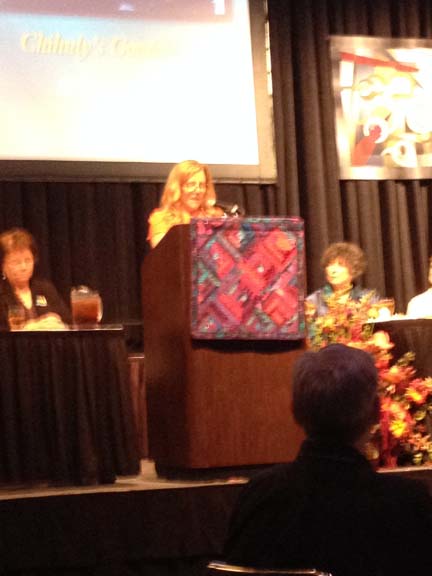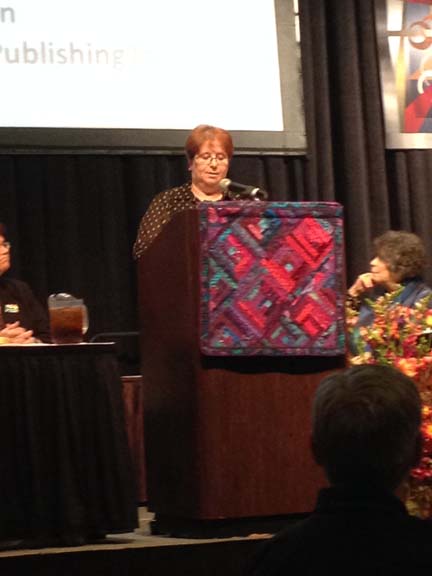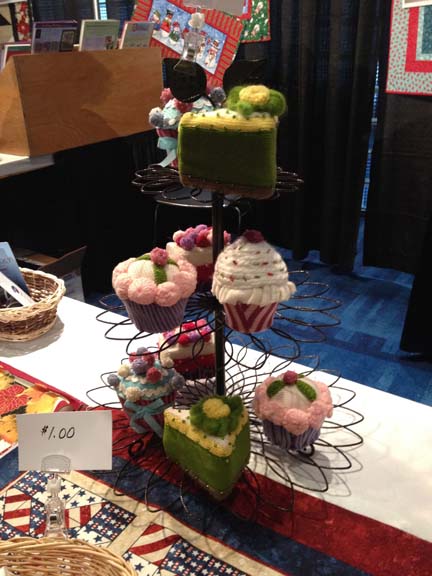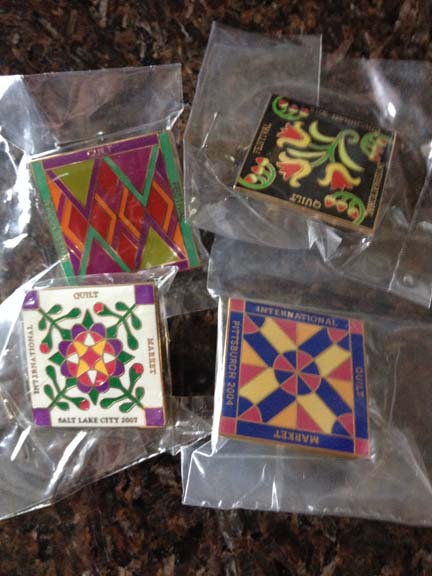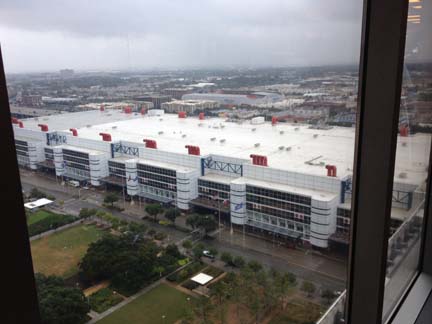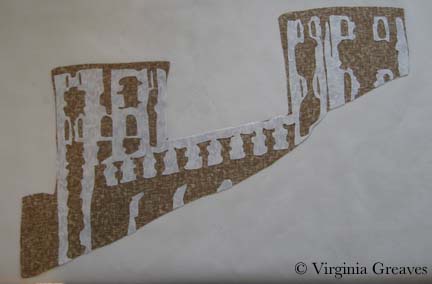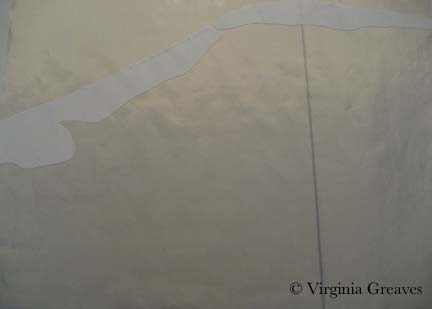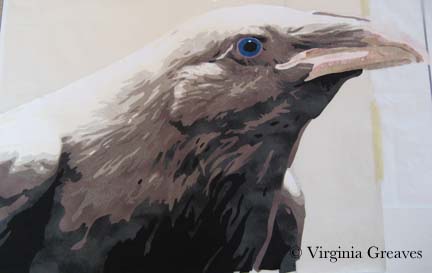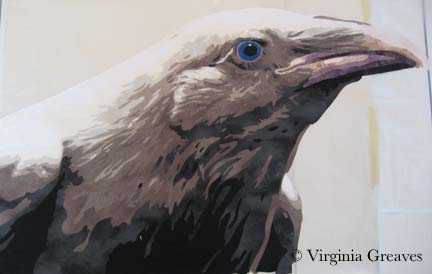Posts tagged white raven

Houston Festival part 2
0After the Winner’s Circle, you can be certain that I hardly slept. I went to the hotel bar (perfect spot for a party of one), had some soup, and then went back to my room to try to sleep.
TWEET: Victoria Findlay Wolfe took this just before I walked on stage last night. #quiltfestival
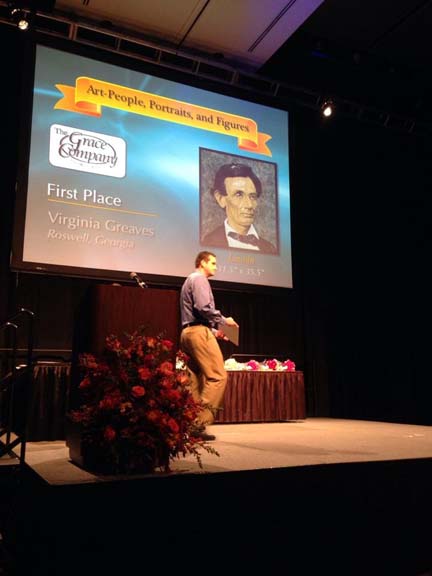
I wish I had a pic of me on the stage. There was a photographer there but I have no idea who he was working for. Anyway, I’m very grateful to Victoria for taking this.
The next day I had a leisurely morning and basically waited for lunch time.
TWEET: Luncheon!
I was so pleased that my new friend Karen sent me a message asking if I wanted to join her for lunch. We met at the door and sat at a table with several of the winners from Japan. They didn’t speak very good English but they were incredibly kind and friendly.
TWEET: Takido Fusako on the left game me a hand sewn flower that is beautiful!
The woman on the left, Takido Fusako (her piece Crest of Tulip won a Judge’s Choice award), gave me a hand sewn pin (which looked awesome on my black jacket). The woman on the right, Sachiko Chiba, gave me an autographed print of her beautiful quilt My Hope that won 3rd place in Hand Quilting.
TWEET: Flower that Takido Fusako gave me. #quiltfestival
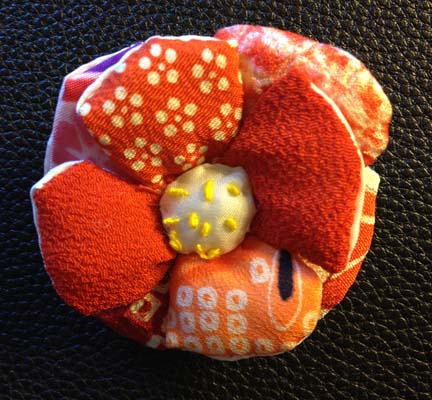
On the stage, all of the top winners ate lunch and then spoke about their piece. The first speaker was Best of Show winner Melissa Sobotka.
TWEET: Melissa Sobotka winner of best of show Chihuly’s Gondola. It’s truly stunning.
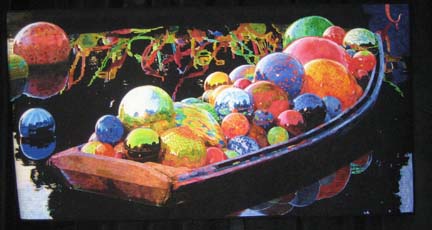
TWEET: Melissa — “pay attention to the judge or blow them off” — love it!
She had shown this quilt at another venue and one of the judges told her that there was a problem with the binding. Melissa’s point is that you either take their opinion or don’t worry about it. She did ultimately choose to take off the binding and re-apply another one before sending it off to Houston for judging.
TWEET: Vicki Anderson owes 18 sewing machines! Her speech on Getting Published.
TWEET: #judimadsen mentioned in her speech – on how to make a beautifully quilted quilt.
I’m Facebook friends with Judi and I follow her beautiful machine quilting so I was excited that Vicki showed her work and gave it its proper praise.
After the luncheon, there were a couple — just a couple — of vendor tables outside. I loved these fabric cakes. It reminded me of the felted teacup I made a few years ago.
TWEET: Too cute!
TWEET: I bought this year’ spin & they gave me freebies for 2004, 2007, & 2012. The one on the top left is this year’s pin.
It was strange walking back to my room, seeing quilters that are famous quilters.
TWEET: I feel like such a stalker. I know their names, I follow them on FB but I can’t bring myself to introduce myself.
I went back to my room and took pics of the Convention Center from there. It is such a large building, I couldn’t even get half of it in a frame.
With time to spare before Preview Night at 5pm, I spent some time in the gym. This is the view from the west tower of the Hilton.
TWEET: Technology is so cool. Delta emailed me a check-in, they txt’d a link to my boarding pass, & I saved it in Passbook for tomorrow.
This is my first time to be completely dependent on my smart phone to check in. I’ll never print another boarding pass.
I had planned on putting everything in one post from this one day in Houston — but this post is growing by the minute. I think I’m going to split the rest of it into another post. So look for a part 3 in a couple of days.

Completing the Raven
0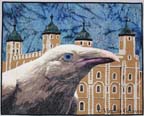 I have finally completed The White Raven. The bird was wonderful — the Tower of London was tedious — but I think in the end that it all came together. It’s ironic that I now have such a creative flow while constructing portraits and my more difficult moments are in the backgrounds.
I have finally completed The White Raven. The bird was wonderful — the Tower of London was tedious — but I think in the end that it all came together. It’s ironic that I now have such a creative flow while constructing portraits and my more difficult moments are in the backgrounds.
I used a stacking type of stitch while quilting the raven to give the impression of feathers — it was interesting to see how the white thread changed the character of the darker fabric shades. I am becoming completely reliant on Isacord thread for free motion quilting. I can run my machine at a high speed and the thread is less likely to shred. It’s also available in a huge selection of colors. A thread run before I start quilting is almost a must for me at this point.
The Tower was not as much continuous line quilting as I would have liked. There was a lot of stopping and starting — so it took much longer to do — but hopefully I’ve created the impression of the Tower in a minimalist way. I still wanted the focus to be on the raven.
The background was also difficult because of the Tower peaks. I started in the middle between two towers and echo stitched a wavy line upwards — but once I reached the top, I attempted to echo stitch back down between another set of towers. Any quilter knows that you have to quilt from the inside out — especially if you’re quilting densely. By quilting from a less dense to a more dense area, I created some ripples that could only be resolved by ripping out all of my quilting and starting over in the correct direction — from the more dense outwards to the less dense area.
 At the end, after I had washed it, blocked it, and added the label, I went back and added more quilting in the raven’s eye. It’s the focus of the piece and it did not have enough quilting relative to what was around it. I didn’t want it to sag over time.
At the end, after I had washed it, blocked it, and added the label, I went back and added more quilting in the raven’s eye. It’s the focus of the piece and it did not have enough quilting relative to what was around it. I didn’t want it to sag over time.
The raven isn’t exactly like the original — I had to take liberties with the beak especially — but I think it is definitely reminiscent of the pictures of Mike Yip. His photographs of the white ravens in the Vancouver Islands are really wonderful.
Adding the Tower of London gave the piece whimsy — a story — which I think adds to the visual interest of the piece.

Applique and the Stabilizer Snob
0I’ve never really addressed applique on my blog. I’ve stated that I do it — I may have even specified that I use a tight zip-zag — but I’ve never really talked about it or why — which seems a great omission given how often I’m asked about it from other quilters.
Some people fuse and then go directly to quilting. I’ve considered this, especially recently. Applique is tedious and is probably the least creative process I do. However, it gives a very neat finish. Raw edge applique without it can get rather messy over time, and I like the completeness that I get with a secured edge. I’ve used a blanket stitch and a satin stitch, but I prefer a tight zigzag — 1.0 mm length & 2.0 mm width (although I vary the width in tight spaces).
Why use stabilizer? I had someone ask me that recently. Years ago, I started using stabilizer and haven’t really questioned why in a long time. The answer is that it gives a professional finish. Yes, there are many layers of fabric which can stabilize the stitch, but in some areas, only two fabrics of cotton are too flimsy. The stitch will look much better if you use a stabilizer.
For years, I’ve been using tearaway stabilizer from embroidery shops. I had one that was soluble for a while but paper-y like a tearway that I really l liked but eventually couldn’t find anymore. When I was making the raven, I used the scraps of all of my old stabilizer. They were all good — except one. We’ll get to that in a minute.
This, by the way, is the beak on my raven as I showed it in my last post. It wasn’t right.
This picture, although taken when my studio was growing dark for the evening, shows how I changed the colors a little.
The raven shows up a little better on my design wall. Whenever I lay something on my design wall, I’m tempted to just lay it on black fabric and call it a day. BUT, my intention in making this piece is part of a story — and I had plans to work on the Tower of London.
I drew a stylized version of the towers and hoped that my fabric choices would get me where I wanted to go. I had no idea if it would work — but I took a leap of faith. This shows the two right towers with the brown decorated with the white architectural details. It was almost like frosting a cake. I was careful to use a white print that wouldn’t show the brown behind it. I would usually put the lighter value down first to avoid shadowing, but this design was more structurally sound to have the full brown background with the white fabric carefully cut and laid on top.
Then I added the black details.
And finally the rusted copper turrets.
The left towers were constructed in the same way.
With the darker details and turrets added, they make more sense.
I put the towers on my design wall — and you can clearly see where the raven will sit. I posted this image to my FB Page and was surprised to find EVERYONE wanted me to finish the piece just like this. It does have a fascinating quality to it — but it isn’t the direction that I was working on. I will certainly consider it for another piece.
This shows the raven sitting on the design wall with the towers. Again, the black background makes everything look good.
This next photo shows the raven and towers once they were appliqued to muslin. Keep in mind that I had run out of my stash of stabilizer. The fabric stores only carried Pellon, and unwilling to take the time to traipse over to an embroidery store, I decided to try it. I use Pellon’s Wonder-Under all the time — how bad could their stabilizer be?
It was AWFUL. It is much thicker than any other stabilizer I’ve ever had, and it often interfered with my ability to move the fabric nimbly under the needle and get the thread where I intended it to go. It is my hope to never have to use it again. So there — I suppose I’m a stabilizer snob.
Certain in the belief that I had nothing in my stash that would do for the sky, I went to the fabric store and picked out a beautiful blue-gray — only to bring it home and find, in the bright natural light of my studio, that the fluorescents of the store had deceived me. The color was more powdery blue than what I wanted. So I searched my stash and found this funky batik. I love its contribution to the story of the piece. It’s a strange choice, but I’m happy with it. This is what the piece now looks like, fully appliqued and ready to be pinned for quilting.
Next week is Spring Break. I may not be able to begin quilting for a while, but I hope to at least get it pinned tomorrow.
One last thing — Martha Sielman has written a second book in her Art Quilt Portfolio series — People & Portraits. My piece, Celtic Woman, is on page 32. I feel privileged to be included — although I’m not overly happy with the photograph. I’ve always prided myself in taking my own pictures — but I’m missing something in terms of color. The printed picture is not anywhere near as good as what I see on my monitor. I need to start using a white balance card when photographing and re-calibrate my monitor.
I received my complimentary copy a couple of weeks ago. Beyond the thrill of having one of my pieces in publication, it’s a nice compilation of work. Several of my FB friends are included and it’s been fun to read more about their work.

The White Raven
1After finishing Firecracker, I did not have another project in mind. I spent a few days doing administrative things — donating my time to do some volunteer work — but then it was time for the rubber to hit the road. If inspiration doesn’t come, you still have to keep creating. So I went looking.
I have had a fascination for years with ravens. I have a newspaper clipping that is probably eight years old on my design wall about the ravens kept at the Tower of London. Legend tells us that if the ravens were to leave the Tower, the Tower and thus the Kingdom of Great Britain would be lost. Charles II declared that at least six be held captive there for the rest of time. Their wings are clipped and they are cared for by a Yeoman Warder.
All of those ravens are common — or black — but there are rare instances of white ravens in British Columbia, Canada. These are not albino ravens with red eyes but rather white ravens with blue eyes.
Which leads me to the inevitable question — what if a white raven were to inhabit the Tower?
There is a wonderful photographer at Qualicum which the white ravens call home — Mike Yip. He very graciously gave me permission to use one of his photographs as inspiration for this piece.
This is the first value — pure white. I started this piece in the late afternoon and the failing light gave me a yellow cast on my design surface.
The second value is almost harder to see as it has a yellow cast to it.

The third value is a little easier to see.
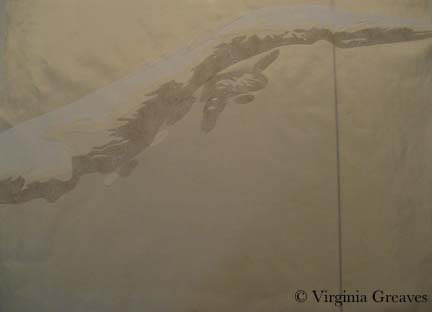
The next day, of course, the light in my studio was better for photography. This is the fourth value and you can really start to see the bird emerge. It is strange to think that a white bird is more than white — but even the majority of the colors in the clouds in the sky are not white. White always has a supporting cast of characters.

This is the fifth value.
And this is the sixth. I had to go outside my stash to find the fabrics for this piece and I had counted on 7 values — but I miscalculated — there are 8. So I took my range of fabrics, tried to figure out where I felt like there was a large enough value jump between two fabrics, and went to my fabric drawer to try to fill it. I was very lucky — I had the perfect fabric that snuggled in perfectly to what I had already set up — and that is the fabric here.
The seventh value goes into gray.
And the eighth and final value is the black.
Then I worked on her eye. I had the perfect blue in my stash. It is actually a little lighter than the blue in the photograph but I think it works well. I’m surprised at how visual I’ve become. I envisioned the exact blue that I wanted and then went to pull it from the drawer.
The beak was tricky. It has a different texture to the feathers and I knew that to make it stand out visually from what I had done previously, I needed to use different fabrics. I liked the range of pink for the top of the beak, but they didn’t work as well for the bottom.
In the photograph, the plum around her eye is repeated in the lower section of the beak — so I tried a range of plums for the lower beak. This is closer to where I want to be. There is always something in a piece that isn’t clear cut.
You’ll notice that I had to tape my smaller pressing sheet to my newer one. I never thought I would go beyond the dimensions of my ultra large pressing sheet — but it didn’t take me long to press the boundaries.
I don’t know if I’ll keep the beak the way it is, but I’ve set it aside on my design wall for now. I’m working on the Tower pieces. Once again, I loved the way she looked so much on the black, I considering giving her a plain background — but then she also looks good on the primary Tower fabric that I chose, so I’m going to experiment with that and see where it takes me.


